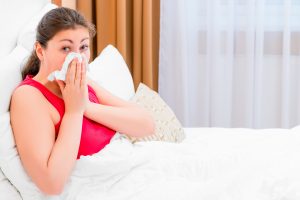Yeast infections — otherwise known as vaginal candidiasis — affect 75% of women. This percentage has been reported by women who have had vaginal candidiasis at least once in their lifetime. Yeast overgrowth infections are pretty common since it’s easy for the vagina to experience an imbalance between yeast cells and healthy bacteria. Read on to learn how to use a baking soda bath for yeast infection.
A yeast overgrowth infection is a fungal infection that you can treat with home remedies. One of these remedies is a baking soda bath. Baking soda has been known to treat vaginal candidiasis and alleviate the symptoms.
What Is a Baking Soda Bath?
While baking soda has many uses, it is popularly used in soda baths to treat yeast infections. It is known to be an effective, quick, and affordable way to relieve symptoms of UTIs and yeast infections. Thus, people have started incorporating this all-around ingredient into fungal treatments and skin diseases. It also helps re-introduce helpful bacteria into the vagina.
A baking soda bath comprises water and a sprinkle of baking soda. This composition has also been known to be revitalizing and relaxing. Moreover, it is an inexpensive treatment that does not require expensive medicines and equipment.
While it has been compared to Epsom salt, baking soda baths differ regarding the conditions treated. For example, a baking soda bath can treat skin conditions. Meanwhile, salt baths deal with blood pressure, nerve function, and the circulatory system.
How Often Can I Take a Baking Soda Bath?
There are many questions surrounding the usage of baking soda in treatment baths for yeast overgrowth infections. Baking soda baths are generally safe. They are often used as a detox bath to neutralize a vagina’s pH level.
It is safe to use baking soda every day to relieve candidiasis. A good number is thrice a day with one to two cups of baking soda for each use. Following these portions, candidiasis symptoms may instantly be lessened or relieved. To achieve the best results, it’s recommended to soak for 10 to 40 minutes in the baking soda bath.
Baking Soda Bath for Yeast Infection
Baking soda is a common household ingredient with various uses, including as a natural cleaning agent and deodorizer. But did you know baking soda can treat conditions like skin candidiasis?
When added to a warm bath, baking soda can help to soothe irritation and restore the skin’s natural pH balance. Additionally, baking soda’s anti-inflammatory properties can help reduce swelling and redness.
Add one cup of baking soda to your bathwater for best results, and soak for 10 to 40 minutes. If you’re prone to yeast overgrowth infections, consider making a baking soda bath part of your regular hygiene routine.
Do Baking Soda Baths Help Candidiasis
Studies show that baking soda helps kill the bacteria that cause yeast overgrowth infections. Candida albicans is a yeast strain that can cause disease in the body. Baking soda has been found to inhibit the growth of this yeast. This means that it can help prevent infections and keep the body healthy.
Adding 1/4 cup of baking soda to a lukewarm bath, as the National Eczema Association recommends, can help reduce itching and irritation.
Baking Soda Bath for Yeast Infection While Pregnant
It is perfectly safe to take a baking soda bath when you’re pregnant.
However, you must consult your doctor before using any new home remedy, particularly during pregnancy. For example, baking soda baths are not recommended for edema, as the high sodium content can cause fluid retention.
Will Baking Soda Bath Help Candidiasis?
Yes, you can use a baking soda bath for yeast infection to instantly alleviate the symptoms of the infection. This study shows that the composition of baking soda can help eliminate the production of Candida cells that cause yeast infections. Moreover, the antifungal effects of baking soda are supported by studies and research.
What Are Some of the Health Benefits Behind This Method?
While there is a multitude of health benefits associated with baking soda baths, these are some of the most common diseases it has been proven to treat aside from yeast infections:
- Athlete’s foot
- Eczema
- Vulvar vestibulitis
- Poison ivy rash
- Psoriasis flare-ups
- Hives
- Body odor
- Chickenpox
These are just some of the most common diseases a baking soda bath has been known to alleviate — skin diseases.
What Are the Side Effects of Baking Soda?
While taking a baking soda bath is generally safe, taking baking soda orally can have several side effects. Therefore, like other remedies, you should not handle baking soda excessively. Otherwise, the following side effects may occur:
Stomach Pain
Excess baking soda can cause stomach pain and other problems such as diarrhea and vomiting. In addition, when baking soda mixes with stomach acid, a dangerous chemical reaction occurs. The byproduct of this reaction might rupture the stomach and cause more severe problems. This is especially true for people who consume too much alcohol or food.
Poisoning
Consumption of a large amount of baking soda powder can cause poisoning and digestive problems. Baking soda’s high sodium content causes this. The poisoning usually starts when the body attempts to balance out the stomach’s salt content. The symptoms to watch out for in case of baking soda poisoning are seizures, kidney failure, breathing difficulties, and dehydration.
Interaction With Medicines
When too much baking soda is consumed, this usually results in interference with other medicines. This also depends on the kind of medication the person is taking. Nonetheless, it is best to take moderate amounts of baking soda for various diseases.
Half a teaspoon of baking soda mixed with half a cup of potable water is enough for most conditions.
How To Prepare a Baking Soda Bath
Drinking water before indulging in a baking soda bath is advised to treat a yeast infection. One can also set the mood by putting up relaxing lights, candles, and music for the whole experience. Here are the simple steps to follow in preparing a baking soda bath:
- Step 1: Mix five tablespoons of baking soda into a water-filled tub. Remember that the amount of baking soda to be incorporated into the bath depends on the condition to be treated.
- Step 2: Mix it with your hands to dissolve the baking soda completely.
- Step 3: Enjoy the bath and soak for approximately 10 to 40 minutes.
Add apple cider vinegar or coconut oil to the baking soda bath for best results.
Ten Benefits of a Baking Soda Bath
Below are some of the benefits one can get from baking soda baths:
1. Treat eczema
The itchy and drying symptoms of eczema are excruciating to the point that the patient might not be able to fight the urge to scratch their skin. Unfortunately, this also leads to flaky skin and injuries caused by extreme scratching.
A baking soda bath, aside from treating yeast infection, can help alleviate symptoms of eczema.
2. Relieve Symptoms of Urinary Tract Infection
UTIs affect a lot of people and have many causes. Baking soda baths have also become more popular due to the prevalence of this disease.
Sodium bicarbonate functions by neutralizing the acidic content of urine. This can ward germs off and help heal UTIs — and yeast overgrowth infections. Moreover, the itchy and burning sensations can also be relieved through a long baking soda bath session.
3. Relieve psoriasis
While you can treat psoriasis with various medications, it would be good to try a baking soda bath first. This is because psoriasis can irritate the patient, and a baking soda bath has instantaneous effects. In addition, this can help relieve the itch associated with psoriasis.
4. Cure Athlete’s Foot
Since baking soda baths are generally used to treat fungal infections, they can also eliminate bacteria and fungi caused by the athlete’s foot. Patients can soak their feet only in a baking soda mixture for convenience.
5. Treat Rash From Poison-Ivy
People who have accidentally touched poison-ivy usually resort to Epsom salt or baking soda baths to relieve itching. It can help minimize the rashes as well.
6. Help Soothe Vulvar Vestibulitis
Vulvar vestibulitis is characterized by intense itching at the opening of the vagina. A baking soda bath may help eliminate the itch if the patient soaks multiple times daily. Three baths will suffice for this kind of condition.
7. Cure Hives
Hives are small bumps caused by specific allergies. These bumps may cause itches and burns. A baking soda bath can help through its antiseptic properties and relieve hives. This will also eliminate redness in the skin.
8. Help With Chickenpox
Since chickenpox can be itchy and irritating, a baking soda bath can relieve these symptoms. A simple soak in a baking soda bath can instantly alleviate the itchiness of the blisters. However, taking the prescribed medicines and a bath is necessary to heal chickenpox.
9. Cure Diaper Rash
Baking soda baths’ antifungal properties can also cure babies’ rashes caused by diapers and reduce their redness. In addition, a bath can instantly alleviate the discomfort associated with the inflammation.
10. Boost Immune System
Taking a baking soda bath is an excellent way to detoxify the body. In addition, baking soda has been reported to support immune health when consumed sparingly or added to baths.
Frequently Asked Questions
Yes, baking soda has been proven to treat candidiasis. A baking soda bath can instantly lessen the symptoms of candidiasis and provide relief.
Generally, showers are preferred. However, if the bath contains baking soda, it can help cure yeast overgrowth infections.
Yes. Some people use baking soda as a vaginal wash. Just mix two teaspoons of baking soda in a mug of water and wash away. You can use it for the vaginal area, but avoid inserting the wash directly into the vaginal canal.
One can take three soda baths daily, depending on the condition.





